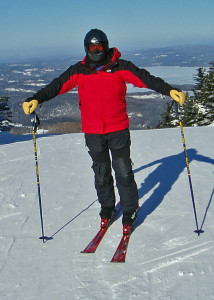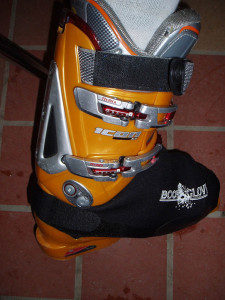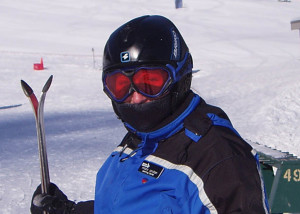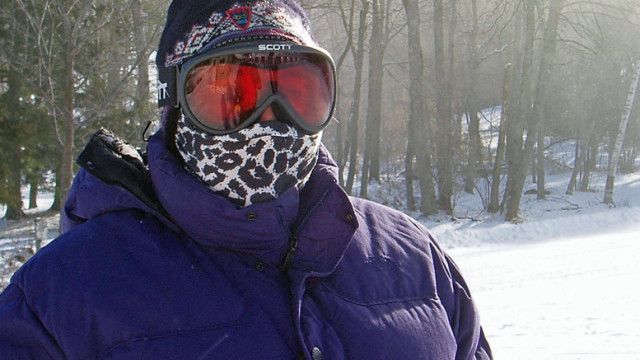
Skiing In Deep Cold: Or, Should We Say “Sk-k-k-kiing in D-D-Deep C-C-Cold”?
Sometimes, with the way the weather dorks on the news blather about “Dangerous Cold” “Wind Chill Factor Advisories,” and, my personal favorite “Polar Vortex,” you’d think they were predicting floods, fires, earthquakes, tornadoes and, quite possibly, the end of civilization as we know it.
Makes those of us in the know laugh out loud while we are out skiing and snowboarding and having a marvelous time on epic snow and empty slopes. It’s perfectly possible to have a wonderful time skiing or riding when the actual air temperature is minus 20. Or colder. Here’s how to do it:
Skiing In Deep ColdDry = Warm
Before you head out make sure your boots, gloves and clothing are perfectly dry — especially your boots.
It’s best if you put your boots on a boot dryer after every use. We like the portable boot dryers, which go on every ski trip, and the larger stay-at-home boot dryers
such as the ones from Dry Guy which will dry both boots and gloves at once.
One note of caution though. If you have heat-molded custom insoles in your boots, the heat from some boot dryers can damage them. Take our word for it.
Skiing In Deep Cold: Fuel the Furnace
Before you ski or ride, eat a hearty breakfast. That’s the fuel to keep you warm until snack time. Remember, calories measure heat output. This is the perfect time for bacon, eggs and hashbrowns, or peanut butter spread thick on whole wheat bread. High fat content is good. Avoid sweets and refined carbs, which provide only short-term fuel . . .you want to stay warm until lunchtime.
Also, drink a couple of extra glasses of water before you ski. Cold dry air dehydrates you, and your body needs to be fully hydrated for maximum thermal efficiency. Coffee and other caffeinated beverages actually help dehydrate you, and alcohol is a real no-no in the cold.
Skiing In Deep Cold: Start at the Skin
Everyone has heard about dressing in layers—but it helps if you have the right layers: Always start with an ultrathin layer of lightweight wicking underwear—wool or polyester–tops and bottoms next to your skin. That way, even if you sweat (in a warm ski lodge, for example ), you’ve always got a warm, dry layer in that critical fraction of an inch next to your skin.
Skiing In Deep Cold: COTTON IS COOL (as in freezing . . .)
Don’t Wear Cotton Next To Your Skin! If you sweat even a little, cotton holds that moisture like a sponge, chilling you quickly. This is especially true on your feet. Feet always sweat and cotton socks are your quickest route to frostbitten toes.
Skiing In Deep Cold: Warm To The Core
When it gets colder, wear more ot thicker insulation layers. Some of us still love a wool sweater, but polyester fleece (Windbloc versions are the warmest) or pile is lighter and warmer and more efficient. Best of all may be a Down or fiberfill “puffy” — great for filling in all the little spaces between you and your shell, but too warm for all but the coldest days These are the layers you can adjust easily, adding or subtracting as necessary.
For your legs, two layers of long johns is sufficient for most weather. In deep cold, try fleece bibs over your lightweight long-johns. Jeans just don’t cut it in deep cold. They are heavy, restrictive and inefficient insulation.
Skiing In Deep Cold: What Windchill?
The key for top and bottom warmth is a windproof outer shell. If the wind can’t get at your skin, “wind chill” doesn’t matter! Whether that windproof shell is separate or part of an insulated garment makes no difference at all. The better wind-stopping layers are tightly woven nylon fabrics. The best are coated with Gore-Tex or a similar waterproof/breathable laminate.
Skiing In Deep Cold: Warm Feet

Today’s ski boots are so warm that cold feet normally shouldn’t be a problem for folks with good circulation–if you start with your boots warm and dry.
If you drive to the hill—even a short drive—make sure your boots are near the heat in the car. Don’t throw them in the trunk or the back of the wagon or, worse, in the clamshell on top! It may be inconvenient for a passenger to have them underfoot for the drive, but it will pay off on the hill.
Heres a real insider’s tip: carry a hair drier in your ski pack. In the ski lodge, give boots a blast of heat just before you put them on. Makes a big difference.
At the end of the day, you can either pull out your liners and leave them in a warm (not hot), dry place with good air circulation, or get yourself some boot dryers.
Socks make a big difference, too. Wool or polyester in the thin, ski-specific socks are best. One good lightweight sock of the proper thickness is warmer than having your toes cramped with heavier socks–which can restrict circulation. If you find your feet getting cold, just head for the lodge, change your socks for warm, dry ones and reheat your boots with your hair drier.
Sad to say, the inexpensive chemical warmer packs probably won’t work if your boots fit properly. There just isn’t room. If you’ve got enough room in your ski boots for two pairs of socks, or thick socks, or a boot warmer pack, your boots are too big and you need new ones. See our discussion on buying boots
If, despite all precautions, your feet still get cold easily, invest in battery powered ski boot heaters and have them installed at a ski shop where they can inlay the heater into your insoles.
A less expensive alternative are neoprene DryGuy Boot Gloves which helps insulate your boots. This is a simple, inexpensive, well made product that really works. We won’t go skiing without a pair in our ski pack.

Skiing In Deep Cold: If Your Feet Are Cold, Put On A Helmet
Once you’ve properly encased your body’s core, it’s much easier to keep your extremities warm. But heads, hands, and feet still require special consideration if you want to play in the snow when it’s really cold
In addition to providing an extra margin of safety, helmets are absolutely the best cold-weather headgear. They are comfortable, warm and windproof and, combined with a windproof face mask and good goggles, a helmet seals your head and face in warmth.
The trend lately has been toward lighter helmets with more ventilation and less padding, but when warmth is critical nothing beats a full-coverage, hard-shell helmet. .
Everyone we know hates face masks, but we always have one (often the the fleece-lined neoprene ones from Gator or Seirus) in our parka pocket, to wear whenever we have to. A fleece neck gaiter with your collar zipped up around it will help seal your neck opening.
Cold weather means layers for your hands, too. We use polypro liner gloves inside insulated mittens, and, in really cold weather, a windproof outer shell mitten over. Mittens are warmer than gloves. If the insulation around your fingers is too thick, it can restrict circulation and leave your fingers cold! If it gets really cold, throw a pair of the little chemical handwamer packs from Grabber or Heat Factory
Skiing In Deep Cold: Ski Smart
If one part of a mountain gets more sun or is more wind-sheltered, ski there. Take advantage of an enclosed tram or gondola or a summit warming hut if the area has one.

Skiing In Deep Cold: The Right Attitude
The final ingredient in skiing or riding comfortably in cold weather is attitude. Don’t plan to stay out the whole day. Instead, take three or four runs and come in to eat more and warm up, then head back out. After all, in deep cold, the snow is often prime and you don’t have to share it with anyone—so you aren’t losing out if you take a break. And you won’t have to wait in lift lines on really cold days.
If you know you are properly dressed, and know you’re going to have a great time on the slopes, you will! Be prepared, and don’t let the cold keep you a prisoner when you should be out enjoying skiing or riding.



Tim covered all of that stuff pretty well, except he left out one thing that BOTH of us do when it’s really cold out. That windproof outer shell still has wristcuffs, a neck opening, and of course the whole waist area…and zippers, pockets, etc. All of those let in stray air currents. If you add a windproof/resistant INNER layer, it blocks those from getting to your core, and adds a huge degree of extra warmth. I have a Mountain Hardware shirt that goes close to my skin that I love. A good windblocking vest can help, too. Or, if you happen to golf and want to save some money (and don’t mind looking like a dork while you’re getting dressed in the lodge), a golf windshirt works extremely well. It’ll help you when you’re going downhill, when you’re on the lift, and even when you’re just standing around. Give it a try!